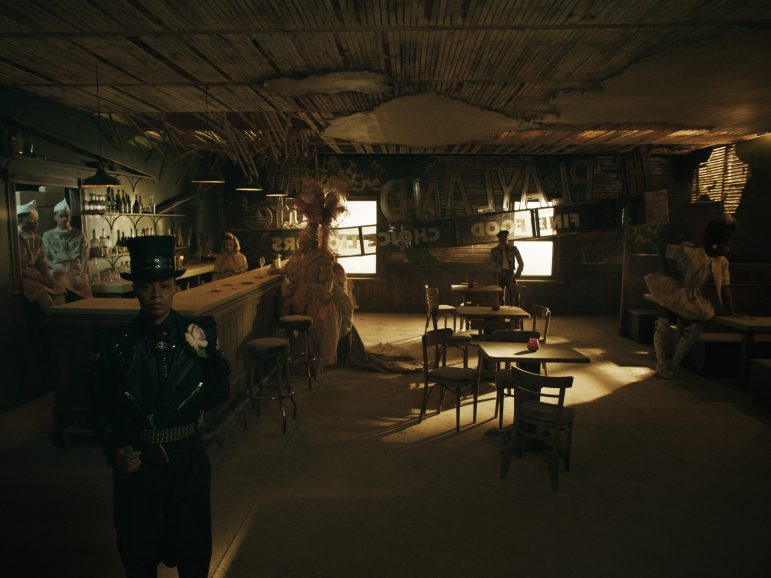Night of fancy
Boston’s oldest – and most notorious – queer bar rises from the ashes for one final night of fun in Georden West’s interdisciplinary spectacle, reuniting a striking cast of characters who worked and played there over the decades.
For six decades, Boston’s Playland Café was a bastion of the city’s LGBTQ+ scene, providing a safe space for an often-oppressed community until its untimely demolition in 1998. Although few traces of its physical footprint remain, filmmaker Georden West has immortalised the influential bar in their debut feature. Drawing comparisons to the work of Derek Jarman and Sally Potter in its experimental nature, Playland is a nostalgia-evoking, genre-bending fusion of theatre, opera and dance that straddles the line between fantasy and documentary.

When Jo Jo Lam was approached by West in mid-2020 about lensing Playland, the opportunity to join a talented cast and crew of LGBT+ creatives in retelling a hidden part of Boston’s queer history intrigued her. Playland would be the first long-form project for the cinematographer, who grew up in Hong Kong and is now based between New York and Paris. “On the one hand [moving to long-form] was scary, just because I hadn’t done it yet,” she admits. “On the other hand, it ended up being less frightening than I thought, because we actually had more time to prep and occasionally more tools to realise certain ideas.”
West sent Lam reams of research about the real Playland and their vision for the film, so the DP could immediately immerse herself in the fantastical world of the bar and its patrons, captured in a series of decades-spanning tableaux. As the shoot would be carefully choreographed with an ensemble cast, the pair spent a lot of their (mostly remote) prep shot-listing.


The director’s original intention was for Playland to be a one-shot, but in practicality that wasn’t possible. “But we kept the spirit of it,” Lam adds. “Essentially, we wanted the camera to feel like it was floating – like it was drifting through crevices of these spaces.”
The conversation of aspect ratio came up early on. “It was about how we portray these workers to be almost stuck in the bar permanently,” explains the DP, “and secondly about creating certain tableaux vivants/moving paintings; and who gets to be ‘archived’ in history’. Because I was involved in the set design conversations, I knew there were going to be a lot of vertical elements in the build.”

She continues: “Location is always a character, and in this film more so than my other films. It was about respecting and honouring the incredible set design in our compositions. Shooting 4:3 makes it fun – I’ve shot in that format before, and it challenges you to compose in new ways.”
Lam looked to filmmaker Roy Andersson’s work as a visual reference, for his skill in composing busy scenes in 4:3. Meanwhile, West was drawn to the work of photographer Irving Penn and his muted, low-contrast images.
Playland’s narrative spans the Café’s opening in 1937 all the way to its closure – a timeline punctuated by recordings of real Playland patrons and the issues they faced. Given the setting, Lam – a Kodak Vision Award for Excellence in Cinematography winner – leant towards shooting on film for its textured aesthetic. In testing she tried out a 16mm camera, a S16mm model, the regular Alexa Mini and the Mini LF, along with a range of lenses from vintage to modern. When the results came back, she loved the look of the 16mm, but West was conscious of “putting nostalgia on nostalgia”.


Fusing contemporary and vintage flair, the team eventually settled on the ARRI Alexa Mini LF, with Canon FDs and Tiffen Glimmerglass filters. “The fantastical costume design spanned decades, but Georden wanted to create a timeless feel. However, shooting on film gave it a definitive time,” explains the DP, who worked with rental house BeCine. “So, we ended up going the other way and went with the Mini LF and more vintage lenses to bring some character and texture back. We shot Open Gate and wanted the most information and resolution since we are also shooting 4:3. The depth of field also felt very different on LF.”
Lam and gaffer Dave Wilwayco had access to a wide variety of tungsten lights at their New England Studios set, using 20K and 12K units for the film’s only daylight sequence. They also had a variety of flexible LED units, which allowed them to dial in specific colour temperatures as the story dictated.

“Most importantly though, we decided to run everything through DMX early on (RatPacks) as we had an insanely tight schedule and it was crucial for us to be able to change looks and set up cues and sequences from early on,” the DP says. “This was a life saver and thanks to our BBE and board op Kai Magee who managed it all!”
In all her work, Lam likes to engage the colourist early on; in Playland’s case “because I knew some of the colours I was going to be dealing with were going to be gnarly,” she smiles. Reuniting with frequent collaborator Andrea Chlebak at Harbor Picture Co., they created a LUT that “ultimately emulated a standard 500T film look. Then she gave me a few alternatives that were more creative – like even bluer – for different kinds of lighting scenarios. I went with the base LUT most of the time.”
Shot in just eight days in summer 2021, Playland was a challenging first feature for the DP and her crew to pull off in the tight timeframe – especially against a pandemic backdrop. “Everyone did a great job – especially our gaffer, key grip (James Arterberry) and Steadicam (Dae Hyun Kim),” she says. “I’m proud of the film coming together as it did and being able to exist in this landscape. It was a very diverse and inclusive set.”










